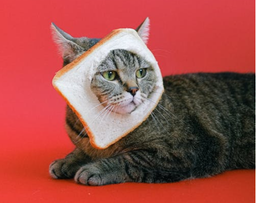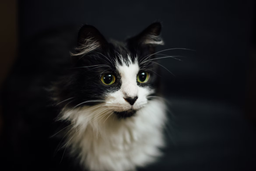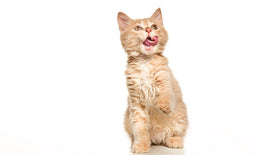Untamed’s Ragdoll feeding guide—what food, how much, and how often [Made easy]
Ragdolls barely hit four months when they are the size of an average adult kitty, and that’s when they still have much growing left to do! Because of their size, they consume larger portions of food than other breeds, but they can still overeat and become fat. We have prepared a comprehensive Ragdoll feeding guide to help you figure out:
- What food is tailored to this breed’s needs
- How much wet or dry food they should consume
- How to adjust their meal schedule according to their life stage
You’ll also learn all about Untamed wet food that can help your Ragdolls flourish effortlessly!

Feeding Ragdolls 101—Get proper cat food! Seasoned home-cooked meals are not a great idea.
Source: ragdoll_dandelion
What should Ragdolls eat?
Behind a Ragdoll cat’s disarming fuzziness is a muscular physique supported by a sturdy skeletal structure. This breed needs a high-protein diet to maintain their large frame, and it’s crucial they get their proteins from meat. Nutritionists say a Ragdoll’s meals should replicate the nutrition profile of the natural feline diet, offering over 50% animal proteins, about 20% fats, and no more than 3% carbs.
Ragdolls are healthiest when they consume whole-meat-based wet food regularly. Whole meat is more nutrient-dense and biologically appropriate than processed protein substitutes, such as:
- Meat, fish, bone, or insect meals
- Plant proteins (gluten, soya, etc.)
- Dairy proteins
As far as daily calories are concerned, Ragdolls should get 90% of their energy from proteins and fats. If you’re confused about how that works, refer to the table below to understand the calorie density of these nutrients:
|
Nutrient |
Calories per gram |
|
Protein |
4 |
|
Fat |
9 |
|
Carbohydrate |
4 |
These nerdy facts boil down to one practical tip—avoid giving Ragdolls carbs. Overconsumption of this nutrient leads to weight gain and stomach sensitivity in this breed. The cat food you choose shouldn’t have high-carb ingredients like:
- Grains (wheat, rice, sweetcorn, etc.)
- Starchy veggies (usually potatoes, peas, and sweet potatoes)
- Sugar (commonly used as a binder in biscuits)
Canned or dry food—what’s better for Ragdolls?
Ragdolls shouldn’t eat dry food, not only because it's high in carbs and processed but also because of its low moisture content. This breed needs about 60 millilitres of water per kilo of their body weight every day. Ragdolls are prone to gastrointestinal and urinary tract issues like constipation, irritable bowel syndrome (IBS), bladder stones, cystitis, and chronic kidney disease (CKD)—all conditions aggravated by a dry food diet.
Most canned cat food products have over 75% moisture content, which keeps your kitty’s system hydrated naturally. Wet food also offers higher values of animal protein than biscuits, making it a better choice for all felines.
Most cat parents choose to feed their felines dry food because it's affordable, but saving a few pounds now means having to pay huge vet bills in the future. High-quality, meat-based wet food is the best way to keep your feline happy and healthy!

When you take your Raggie out for some exercise, but the slothful prodigy finds a hack to doze off…
Source: flaming_nugget
How much should I feed my Ragdoll cat?
Ragdolls may be big eaters because of their size, but you should be mindful of their portions because they’re exceptionally lazy indoor cats. Most Raggies spend their time idly hanging out around their humans, hardly managing a jump or two throughout the day. Their leisurely lifestyle means they need about 40–42 calories per kilo of their body weight every day for quality sustenance.
This breed’s daily caloric needs vary according to their weight and life stage. Check out the table below to get an estimate of how many calories Ragdoll adults need:
|
Gender |
Weight |
Calories/day |
|
Male Ragdoll (neutered or intact) |
5.5–9.5 kilos |
250–400 calories |
|
Female Ragdoll |
3.7–6.8 kilos |
180–300 calories |
Translating these calories to a suitable portion of dry or wet food is a challenge because of the wide pool of ingredients manufacturers use in cat food. On average, dry food is more calorie-dense than wet food as it's loaded with carb-rich fillers and fatty taste enhancers. One cup of kitty biscuits usually contains 300–450 calories.
A standard 70g–85g can of wet food offers 80–120 calories, depending on the source of protein. Most Ragdolls do well on two such cans in a day, but if your kitty is ginormous or gets regular exercise, they may need an extra can.
In case you serve a mixed diet, a balanced daily menu would include at least one can of wet food and not more than 50 grams of dry food.
Now that we’ve discussed the caloric values of different products, let’s look into age-appropriate feeding solutions for Ragdoll kittens and seniors.
Ragdoll kitten feeding guide
Ragdoll kittens need more food per kilo of their body weight than adults because of their intensive growth needs. Once your kitten is weaned off, you should gradually increase their food portions according to their weight and activity levels. Since their digestive tract is tiny, spread out their daily ration across 4–6 meals.

Keep the nom-noms coming, hooman. Our tummies are like the TARDIS—they’re bigger on the inside!
Source: bailey.mylo
Post weaning, a kitten’s caloric needs rise at a rapid pace. It’s not uncommon for this breed to need up to five wet food cans in a day during kittenhood! The Ragdoll feeding chart below will help you determine suitable serving sizes according to your kitty’s individual growth:
|
Weight of a Ragdoll kitten (in kilos) |
Calorie intake per day (approximate) |
|
1 |
163 |
|
1.5 |
227 |
|
1.9 |
272 |
|
2.4 |
327 |
|
2.8 |
369 |
|
3.2 |
422 |
|
3.6 |
459 |
|
4.1 |
505 |
|
4.6 and up |
543 |
When your kitten achieves their mature weight, gradually decrease their calorie intake to adult servings.
Watch out for kitten food products that contain insane amounts of carbs to provide more calories. Younglings do need a high-calorie diet, but the calories must come from protein, not carbs. Ragdolls on high-carb products tend to pile on body fat instead of muscles. You should ensure your kitty consumes lean proteins from poultry and fish. Avoid high-fat protein sources like eggs, pork, beef, and lamb.
Feeding senior Ragdoll cats
Senior Ragdolls are super mellow and may spend the better part of the day snoozing, but their caloric needs more or less remain the same. Once your kitty reaches the geriatric stage (when they’re around 11 years old), they start losing weight, and their metabolism slows down. That’s when you should reduce their meal portions by 20%–30% to suit their appetite.

Don’t worry, old age has its perks, hooman. For starters, I now know one hundred ways to be there for you, on good days and bad.
Source: Yuval Zukerman
You may also notice a shift in your elderly Ragdoll’s eating habits if they’re bogged down by age-related illnesses, such as:
- Hypertrophic cardiomyopathy (HCM)—Ragdolls are genetically prone to HCM, which is the thickening of the heart’s walls. This condition, often aggravated by hyperthyroidism, can be prevented or delayed by feeding taurine-rich meat (chicken, tuna, salmon, etc.) to kitties from a young age
- Diabetes mellitus—Feline diabetes is common in older and obese kitties who’ve been on a dry food diet all their lives. Symptoms of this condition include gorging, frequent thirst, and excessive urination. You can manage the health of diabetic cats with prescription meds and sugar- and grain-free meals
- Teeth and gum disease—Periodontitis and tooth loss are common in senior felines. If your kitty is struggling to chew, they may gag and throw up undigested food
- Gastric ulcers—Elderly Ragdolls with gastric ulcers suffer from extreme weight loss, chronic vomiting and diarrhoea, and complete loss of appetite. The condition needs immediate medical attention
Keep your Ragdoll hale and hearty by feeding them Untamed wet food!
Keeping a Ragdoll healthy is not rocket science, but finding suitable cat food sure is an uphill task. From investigating the source of proteins to calculating the value of carbs and fillers, the chore can be agonising—but not if you go Untamed!
At Untamed, we prepare formulas that honour a cat’s biological needs. Our gravy and jelly products are over 60% lean whole meat that helps Ragdolls maintain muscle tone and suitable weight. That’s twice more proteins than what most retail products offer! Our food is made without iffy fillers like grains, meat derivatives, plant proteins, sugar, and chemical additives.

All Ragdolls can have a ball every day on nutritious and super delish whole meat meals from Untamed!
Image (c) Untamed
Our recipes are designed by vets to suit the needs of all cats, irrespective of breed or life stage. We ensure your kitty enjoys balanced nutrition. Our meals are:
- Made with human-grade meat—We don’t use animal byproducts but exclusively human-grade meat, which automatically makes our meals nutritionally superior
- Highly digestible—We steam the ingredients gently to ensure the meat is hygienic, soft, juicy, and easy to digest
- Allergen-free—Our products are free from all common allergens. If your kitty suffers from food allergies or stomach sensitivities, our single-protein Chocka Chicken and Tuck-in Tuna dishes can stabilise their digestion
- Super delicious—If your Ragdoll is a fussy diva, our aromatic meals will lure them in, and the unbeatable taste will win them over! For variety lovers, we offer delicacies with chicken breast and liver, tuna, duck, salmon, mackerel, sardine, shrimp, and ham
Take our TRY NOW quiz to check out which Untamed products would woo your kitty. You can order a taster pack at the best price!
Your kitty can live it up at every age with Untamed!
Our high-protein whole meat diet promotes feline health from kittenhood to senior years. It’s perfect for preventing common feline illnesses like diabetes, arthritis, and UTIs. Our products can help:
- Manage weight in obesity-prone felines
- Improve body mass in anorexic cats
- Minimise gastrointestinal issues like regurgitation and barfing
- Support nutritional needs of pregnant queens
- Stabilise weight in seniors
If your kitty has turned up their nose at wet food before, you won’t have to worry about rejection with us! Our clients have had zero trouble transitioning their kitty to our yummy meals. Here’s what they have to share about the many upsides of feeding their cats Untamed:
|
Timeline |
The Untamed effect |
|
One week |
|
|
Two to four months |
|
|
Six months and up |
|

The Untamed temptation—I can be perfectly active if I want to, hooman. Just find me the right motivation!
Image (c) Untamed
Surprise your Raggie with our taster pack!
The Untamed cat food trial pack is a mini gateway to our top-tier products, and you can order one for your Ragdoll right away. All you have to do is follow these steps:
- Take our TRY NOW quiz
- Enter info about your Ragdoll’s:
- Life stage
- Food allergies
- Food sensitivities
- Taste preferences
- Select the products and place your order
You will receive your taster pack within one day. If your kitty welcomes our meals, we can bring monthly supplies of cat food to your doorstep and save you time! Our shipping is free of charge, and you can cancel, modify, or postpone orders to suit your needs.
We have built our operations on ethical production values. We keep our carbon footprint neutral by using recyclable packaging. The same goes for our raw materials—the meat we use is humanely farmed, and we get our seafood from sustainable and dolphin-safe suppliers.
The right snacks to help your Ragdoll thrive!
Part of the reason why Ragdolls are prone to obesity are their enthusiastic snacking habits! We know they’re endearing kitties, but try not to give in to their begging, especially when they’re eyeing unhealthy snacks, which include anything too salty, greasy, or sweet. So cake, cheese, ice cream, crisps, peanut butter, or honey should be off their menu.

Vigilant gatekeepers—What’s in it for me, hooman? How bout you bribe me with a snack, and I reward you with some cuddles?
Source: kc_ragdollentertainment
Here are some low-calorie snacks for them to enjoy (in small quantities):
- Homemade meat soup or broth
- Edible plants like catnip and cat grass (can also help eliminate the infamous Ragdoll hairballs!)
- Raw chicken or turkey (follow stringent sanitary protocols for raw snacks)
- Air-popped, unseasoned popcorn
- Non-fat yoghurt
- Semi-moist treats
Never give your kitty food with toxic ingredients, such as onions, garlic, grapes, xylitol, caffeine, and alcohol, as they may lead to food poisoning.

![Best food for Ragdoll cats in the UK [Broken Down]](http://untamed.com/cdn/shop/articles/featured_best_food_for_ragdoll_cats_uk.jpg?v=1646818249&width=256)

